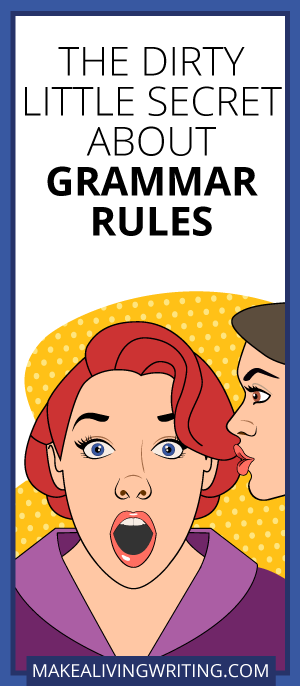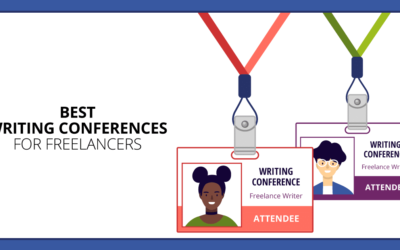
I do. When I teach university English and when I write for freelance clients.
I’m torn between the need to follow all the grammar rules taught in school, and the need to break them. It’s like I’m living a double life.
On one hand, it feels like being a concert violinist, sitting stiffly in a black tuxedo on a black metal chair, violin wedged against a black bowtie, playing full concertos in the key of E minor. It’s lovely…
But I’d rather be down at the pub. Fiddling hornpipes, reels, and jigs. Stomping my foot. Jammin’ with mates on guitar. Mandolin. And whistle.
Expressive. Emotional. And free.
But if you’re always stuck on grammar rules that hold you back, you’ll never be that kind of freelance writer.
I may be a university English teacher, but if you want to be a better freelance writer, you need to know this dirty little secret about grammar rules:
An English teacher’s grammar rules confession

Joe Nattress
I’m not a musician. I don’t play in a symphony. And to be kind, I’ll spare you the pub stories…
I’m a university English teacher in Japan. I teach students to write academic research papers. Dry, conservative papers that, to be honest, aren’t written for the reader.
My students need to learn how to write them to thrive at the overseas universities they wish to attend.
But I’m also a freelance writer. For me to thrive, I need to break the very grammar rules I teach.
You can see the conflict.
Are old-school grammar rules you learned from an English teacher are holding you back?
If you want to sound more like a copywriter than an academic, and attract more freelance writing clients, let me fill you in on a dirty little secret. You should ignore these five grammar rules:
1. Write long paragraphs (please, stop)
Academic paragraphs are long. This allows for detailed topic support. And it may be useful for explaining complicated topics and analysis, but nowadays, readers have too many choices available.
Fail: Most content readers won’t spend time reading long paragraphs, especially online or on a smart phone.
As a freelance writer, your first job is to grab the reader’s attention. You need to immediately let the reader (or the editor you’re pitching) know that your content will be easy to read.
Win: One of the quickest ways to do this. Use short paragraphs.
Short paragraphs leave white space on the page.
White space is inviting.
It tells the reader that this piece of content will be quick to read and easy to scan.
2. Write long sentences (you’re killing me)
Similarly, in academic writing, long, drawn-out sentences with multiple clauses that continue on, line after line, connected by a variety of conjunctions and transitions, are acceptable, as long as the grammar is correct, and the message is relatively clear. (40 words, was that long enough for you?)
Long sentences can also be hard to follow. This is especially true for the perpetually-distracted reader.
Some of my better students experiment with long, complex sentences. This is good for them as they improve their English grammar. But even with correct grammar, readers can get lost in long sentences long before the end.
Fail: If someone has to read and re-read your writing to try and figure out what you’re trying to say, you’ve failed.
Remember trying to make sense of the writing in academic textbooks and research papers?
Me, too. And it sometimes gives me nightmares.
Win: Shorter sentences are easier to read.
3. Use academic vocabulary (Zzz…zzz…zzz)
Many academic writers admire an extensive vocabulary. After all, why would use “walk” when you could just as easily use “perambulate”? Good heavens, that’s going to put the reader to sleep.
To be fair, I’m an academic to a certain degree. I admire scholars for the depth of their knowledge.
But I wouldn’t hire most of them to write marketing content.
Fail: Most readers aren’t going to reach for a dictionary to read our content. And certainly not several times in the same sentence.
In direct response copywriting, they talk about the “greased slide” based on the type of writing you’re doing, such as:
- The sales page. You want your reader’s eyes to flow smoothly from top to bottom of the sales page without stopping for a moment. When a reader stops, the spell may be broken, defense mechanisms may kick in, and the sale can be lost in an instant.
- The magazine article or blog post. It’s similar in a magazine article or blog post. If your reader must stop to figure out the meaning of a word, it may snap the reader out of the story.
This presents an opportunity for outside thoughts of daily life to rush in. Your reader may remember it’s time to get back to work or pick up the kids. They may never finish your article.
Win. Using everyday language does not mean dumbing down your content. It means explaining ideas in simple language. Even the most complex ideas can be explained using common vocabulary.
This helps to hold your readers’ interest.
4. Use formal language (epic fail)
As an academic English teacher, I tell my students not to use casual language and contractions in their writing. Written language is different from spoken language.
Fail: Formal language often does not develop the connection between writer and reader the way casual language does.
Imagine meeting someone for the first time. Most of us bond more quickly with someone who’s relaxed and easy to talk with.
Win: Write as if you’re talking to a friend, and you’ll draw the reader in.
One way to do this is to use contractions.
That’s how we speak.
I laugh when I edit my freelance writing and put in contractions. My inner student still loves to break the rules, even when they’re my own.
5. Obey grammar rules (rules were meant to be broken)
To really write like we speak, we need to…break grammar rules.
There. I said it.
Keep that between us, okay?
Please don’t tell my students I said that. I’ll never live it down.
If they saw how I write online and for clients, I’d lose all credibility in my Writing Academic Research Papers classes.
They’d never want to write a research paper again.
Despite what English teachers have told you, it’s OK to break grammar rules.
Really.
Because, again, that’s how we speak.
This doesn’t mean we can disregard all grammar rules. It means we can strategically break them when it enhances our writing with:
- Sentence fragments
- One-word sentences
- And sentences starting with conjunctions.
All are acceptable if your audience understands and your ideas flow smoothly.
Break the rules to be a better freelance writer
It was hard for me at first to ignore these five grammar rules. I imagined hearing my English teachers complain whenever I dared to disregard their instructions.
But if you learn to ignore these grammar rules, you’ll be a better freelance writer. You’ll engage more readers. You’ll get a better response rate from pitching editors and marketing directors. And you’ll land more assignments.
What grammar rules do you break? Let’s discuss in the comments below.
Joe Nattress is a freelance writer and English teacher who divides his time between Kyoto, Japan and Northeastern Thailand. He writes marketing content for social enterprises, B Corporations and nonprofits.










